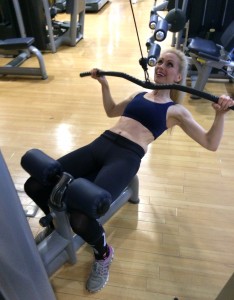Let’s continue the RTM’s series on top gym technique tips by putting your back into it – literally and laterally.
The lateral pulldown is a classic gym exercise that is excellent for strengthening and toning the big latissimus dorsi muscles at the sides of the back, and the trapezius muscle between the shoulder blades, as well as the biceps and brachialis muscles of the upper and middle arms.
Unfortunately, it’s also one of those exercises that is often performed incorrectly and sometimes dangerously so. I think this is due to several reasons.
Firstly, the description of the action and muscles involved are not always posted at eye level, and the same goes for correct technique. Participants would also benefit considerably by having a mirror positioned at a right angle to the machine so they can check their posture, which isn’t always the case.
But the biggest problem is participants trying to lift weights that are too heavy for them. Cue: the sound of weights hitting the stack. Cue: widespread flinching.
Consequently, there is a lack of control involved in an exercise that could at best reduce its effectiveness and at worst cause damage, particularly to the back.
Happily, this is easily resolved with proper technique. The key point to remember is a vertical cable + continuous pace = total control. And total control means safer, better and swifter results. The ideal formula.
First, the seat. Sit at the bench and adjust the roller pad so it sits snugly on top of the thighs. This helps to establish and maintain a safe and secure sitting position, and helps to align the posture throughout the movement.
The weights and your upper body should move – the lower half shouldn’t.
Lean forward and select a weight that is suitable for your goals. Remember, it is always better to underestimate than overestimate to prevent injury. Stand up and take an overhand grip on the bar, with the hands about one-and-a-half to two times shoulder-width apart.
Take the weight and slowly sit down on the bench with the body positioned directly below the bar. The arms should be straight but not locked out to prevent damaging the elbow joints. The back should be upright and stomach muscles braced.
Using a smooth and controlled movement, pull the bar down in front of the head to chest height. Lead with the elbows. Ensure the cable is vertical as you pull down. Maintain an upright back throughout with stomach muscles braced. Don’t lean back. All the movement should come from the arms.
Maintaining the same smooth controlled action, return slowly to the starting position, without the weight touching the stack. Repeat the movement, keeping the same pace throughout.
Don’t snatch the bar down, shuffle on the bench or release the weights. Remember, the more controlled the action, the safer, better and swifter the results.
If the whole movement cannot be performed smoothly and continuously, then the weight is too heavy and should be reduced. Don’t pop a vein for the sake of vanity.
To return the bar, keep the arms straight and slowly stand up, taking care not to rush. The descent of the weight onto the stack must also be controlled. Never crash the stack. Bad form – and nerve-wracking for those within earshot.
Changing the grip on this exercise to a close one puts more emphasis on the biceps, and involves the upper pectoral muscles in the chest.
The body position is the same but extra focus is needed to keep the back upright and stomach braced, as there is a tendency to lean back.
This time, the grip is underhand, with the hands shoulder-width apart. Again leading with the elbows, pull the bar down to slightly below shoulder level.
Return slowly to the starting position without the weight touching the stack and repeat, keeping the movement smooth and continuous.
Smooth. Continuous. Controlled. Silent. The perfect pulldown.




Comments are closed.